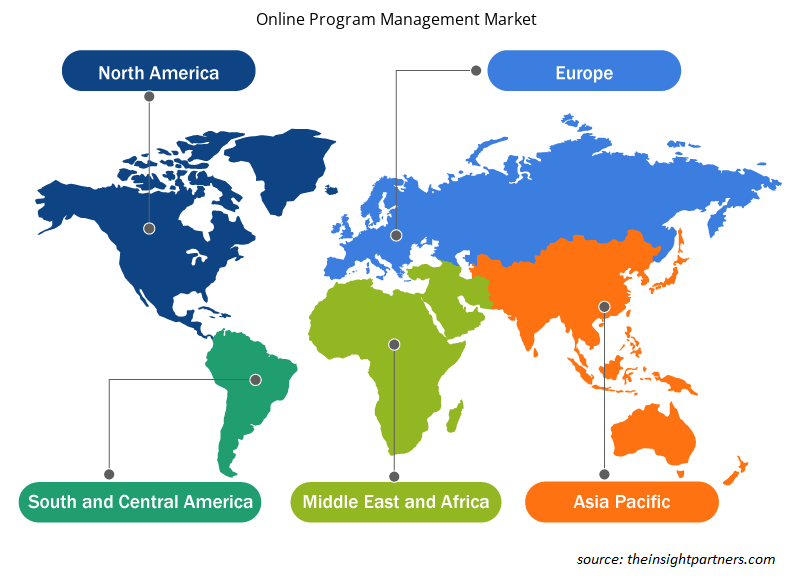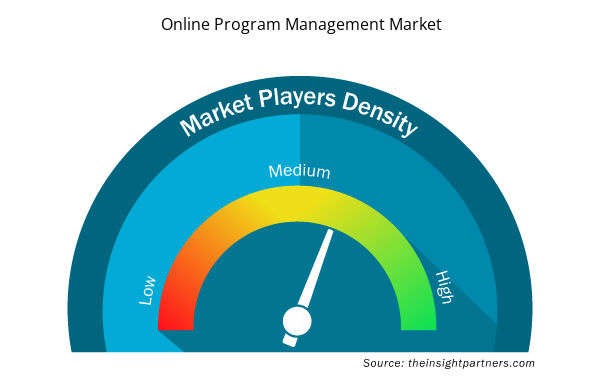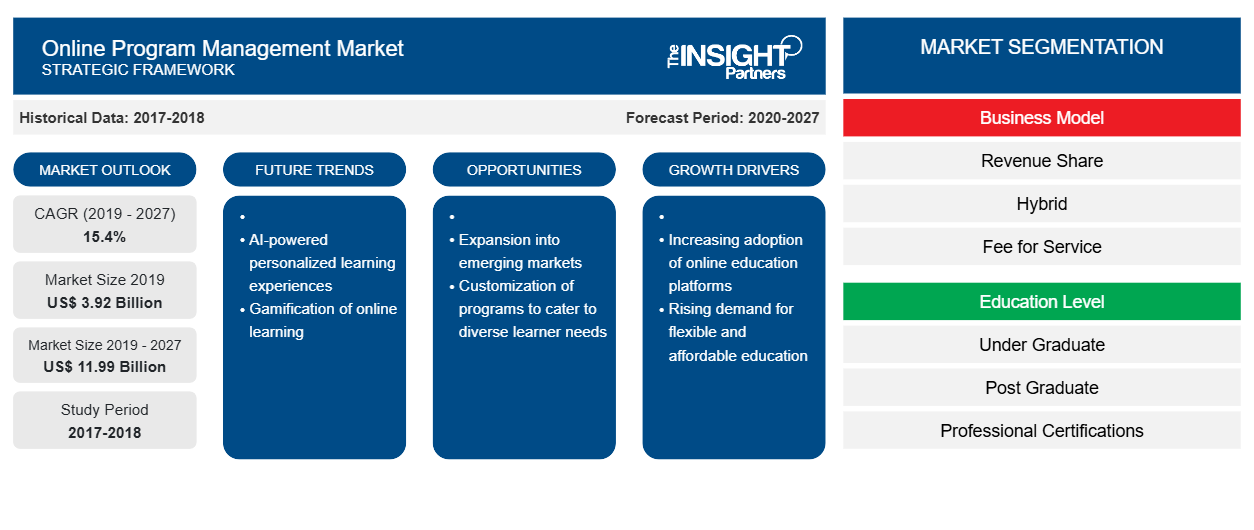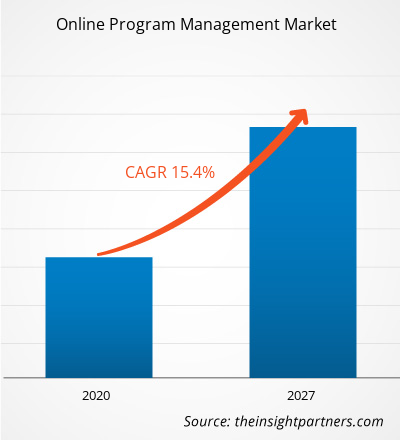Der Markt für Online-Programmmanagement wurde im Jahr 2019 auf 3.916,3 Millionen US-Dollar geschätzt und soll von 2020 bis 2027 mit einer durchschnittlichen jährlichen Wachstumsrate von 15,4 % wachsen und bis 2027 einen Wert von 11.986,4 Millionen US-Dollar erreichen.
Online-Programmmanagement (OPM) umfasst die Unterstützung von Studenten, die Bearbeitung von Registrierungen, die Durchführung von Marktforschung und -analysen und bietet die neueste Marketing-Technologie-Infrastruktur. Das mit dem Online-Programmmanagement befasste Team besteht aus Experten für digitales Marketing, Datenanalysten, Bildungstechnologen, Webentwicklern und Spezialisten für Studentenbetreuung, um einen mühelosen Prozess für Studenten zu schaffen. Online-Abschlüsse sind mittlerweile weit verbreitet und werden von mehreren Colleges und Universitäten angeboten. Jedes Jahr melden sich Studenten aller Einrichtungen für Online-Kurse an. Der Markt für Online-Programmmanagement ist ein stark fragmentierter und wettbewerbsintensiver Markt. Da führende Unternehmen in diesem Markt ihren Zielmarkt weiter ausbauen, indem sie ihr aktuelles Angebot erweitern und ihren Kundenstamm diversifizieren, sehen sich alle führenden Akteure einem zunehmenden Wettbewerb gegenüber, sowohl von Start-ups als auch von den führenden etablierten Unternehmen der Welt. Mehrere Unternehmen in der Wertschöpfungskette übernehmen andere Marktteilnehmer, um ihre Position auf dem Markt zu behaupten und ihren Kunden effiziente Dienstleistungen anzubieten. Die wichtigsten Unternehmen der Online-Programmmanagement-Anbieter haben ihren Sitz in Nordamerika und hauptsächlich in den USA. Der Markt dringt jedoch mit einer hohen Wachstumsrate in die APAC-Region vor.
Verschiedene Unternehmen in Nordamerika bieten Hochschulen und Universitäten Online-Programmmanagementlösungen an, und diese Lösungen werden im Bildungssektor allgemein akzeptiert. Die steigende Nachfrage nach E-Learning und die zunehmende Betonung effektiven Lernens treiben das Wachstum des Bildungsmarkts in der Region an. Die zunehmenden Initiativen von Regierungen wie die staatlichen Studienbeihilfeprogramme und der zunehmende Trend, technologische Fortschritte für die Entwicklung innovativer Online-Programmmanagementlösungen durch private und öffentliche Institute zu nutzen, treiben das Wachstum des Online-Programmmanagementmarkts voran.
Passen Sie diesen Bericht Ihren Anforderungen an
Sie erhalten kostenlos individuelle Anpassungen an jedem Bericht, einschließlich Teilen dieses Berichts oder einer Analyse auf Länderebene, eines Excel-Datenpakets sowie tolle Angebote und Rabatte für Start-ups und Universitäten.
- Holen Sie sich die wichtigsten Markttrends aus diesem Bericht.Dieses KOSTENLOSE Beispiel umfasst eine Datenanalyse von Markttrends bis hin zu Schätzungen und Prognosen.
Markteinblicke
Die steigende Nachfrage nach Online-Bildung treibt das Wachstum des Marktes für Online-Programmmanagement voran
Online-Lernen wird zu einem wesentlichen Bestandteil der Bildungslandschaft. Die Einschreibungen in Online-Programme werden zunehmend durch die steigende Zahl von Studenten vorangetrieben, die nach flexiblen Formaten für Zertifikate, Kurse und Studiengänge suchen, um ihre berufliche Karriere zu unterstützen und weiterführende Studien zu verfolgen. Studenten, die sich für Programme auf dem Campus eingeschrieben haben, konzentrieren sich während ihrer Einschreibung auch darauf, sich für Hybrid- oder Online-Kurse anzumelden. Online-Bachelor-Abschlüsse boomen unter Studenten, da viele renommierte und große Institutionen aufgrund der hochwertigen technischen Unterstützung beim Lernerlebnis auf verschiedene Online-Studiengänge umsteigen. Darüber hinaus konzentrieren sich die heutigen Doktoranden aktiv darauf, virtuelle Kurse für ihr weiterführendes Studium zu belegen. Beispielsweise gewinnt das Fernstudium für den MBA-Kurs an Popularität, wobei die Zahl der Online-MBA-Kurse von Jahr zu Jahr stark zunimmt. Die Anmeldungen für diese Art von Programmen nehmen an öffentlichen und gemeinnützigen Universitäten zu, da die Nachfrage nach virtuellen Programmen steigt, was voraussichtlich das Wachstum des Marktes für Online-Programmmanagement fördern wird. Darüber hinaus spielt der steigende Bedarf an berufsbezogener Kompetenzentwicklung und lebenslangem Lernen eine wesentliche Rolle bei der Förderung des Wachstums von Online-Programmen. Für Anbieter von Online-Programmen decken die Käufer von Zertifikatskursen ein großes Segment ab, da zahlreiche Studenten Online-Kurse zur Verbesserung ihrer Kompetenzen wählen und diese Kurse mit Branchenstandards verbunden sind. Durch den Erwerb von Zertifizierungen in ihrem Fachgebiet steigern Fachleute nun ihren Wert für das Unternehmen sowie ihre Position. Diese ehrgeizige Entscheidung soll sie außerdem über die Technologie, Branchentrends und viele andere Themenbereiche auf dem Laufenden halten, die sich weltweit ständig weiterentwickeln. Indem man durch die Wahl verschiedener und geeigneter Kurse auf dem Laufenden bleibt und sich weiterbildet, bietet man sich die besten Chancen, die individuelle Karriere im gegenwärtigen Szenario voranzutreiben. Beispielsweise haben viele Online-Bildungsportale und Hochschulen aufgrund der wachsenden Popularität der Datenanalyse unter den Studenten eine Reihe von Kursen zu Datenanalyse und Datenmarktforschung entwickelt. Die steigende Nachfrage sowohl nach Online-Abschlüssen als auch nach professionellen Kursen fördert also das Wachstum des Marktes für Online-Programmmanagement.
Einblicke in Geschäftsmodelle
Im Geschäftsmodellsegment hat der Umsatzanteil den größten Anteil am globalen Markt für Online-Programmmanagement eingenommen. Der Umsatzanteil ist ein langfristiges, institutionenweites Partnerschaftsmodell, das begrenzte Investitionen von Institutionen für die Durchführung und Aufrechterhaltung des Projekts erfordert. In diesem Modell ist das finanzielle Risiko für die Partnerinstitution begrenzt, da OPM-Anbieter den Großteil des Investitionskapitals bereitstellen.
Einblicke auf Bildungsniveau
Der Markt für Online-Programmmanagement ist nach Anwendung segmentiert in Bachelor-, Master- und Berufsabschlüsse usw. Das Segment der Masterabschlüsse hat den dominierenden Anteil am globalen Markt für Online-Programmmanagement.
Auswirkungen von COVID-19 auf den Markt für Online-Programmmanagement
Das Coronavirus hat das Bildungssystem weltweit beeinträchtigt. Dies hat zur Schließung vieler Universitäten und Schulen geführt. Dies hat sich negativ auf den Betrieb von Schulen und Hochschulen ausgewirkt. Als Reaktion auf die Schließung von Schulen und Universitäten aufgrund von COVID-19 hat die UNESCO empfohlen, offene Bildungsanwendungen und Online-Fernlernprogramme für den Fernunterricht zu verwenden. Dies stellt eine große Chance für Anbieter von Online-Programmverwaltungsdiensten dar. Der Mangel an Internetkonnektivität und unterstützender Infrastruktur bleibt jedoch eine Herausforderung.
Fusions- und Übernahmestrategien werden häufig von Unternehmen verfolgt, um ihre Präsenz weltweit zu erweitern und der wachsenden Nachfrage gerecht zu werden. Diese Strategie wird vor allem in Nordamerika verfolgt. Einige der jüngsten Übernahmen sind unten aufgeführt:
2018: Wiley hat The Learning House, Inc. übernommen. Dadurch wurden die Unternehmen erweitert, die Online-Programmverwaltungsdienste anbieten, darunter Graduierten- und Bachelorprogramme, Kurzkurse, Bootcamps und mehr für internationale Studierende, berufliche Weiterbildungsdienste für Lehrer und mehr.
2017: 2U hat Get Educated International Proprietary Limited übernommen. Das Unternehmen hat Get Educated International Proprietary Limited übernommen. Infolgedessen verwaltet das Unternehmen seine Geschäftstätigkeit nun über zwei berichtspflichtige Segmente.
Regionale Einblicke in den Markt für Online-Programmmanagement
Die regionalen Trends und Faktoren, die den Online-Programmmanagement-Markt während des Prognosezeitraums beeinflussen, wurden von den Analysten von Insight Partners ausführlich erläutert. In diesem Abschnitt werden auch die Marktsegmente und die Geografie des Online-Programmmanagements in Nordamerika, Europa, im asiatisch-pazifischen Raum, im Nahen Osten und Afrika sowie in Süd- und Mittelamerika erörtert.

- Erhalten Sie regionale Daten zum Online-Programmmanagement-Markt
Umfang des Marktberichts zum Online-Programmmanagement
| Berichtsattribut | Details |
|---|---|
| Marktgröße im Jahr 2019 | 3,92 Milliarden US-Dollar |
| Marktgröße bis 2027 | 11,99 Milliarden US-Dollar |
| Globale CAGR (2019 - 2027) | 15,4 % |
| Historische Daten | 2017-2018 |
| Prognosezeitraum | 2020–2027 |
| Abgedeckte Segmente | Nach Geschäftsmodell
|
| Abgedeckte Regionen und Länder | Nordamerika
|
| Marktführer und wichtige Unternehmensprofile |
|
Dichte der Marktteilnehmer im Bereich Online-Programmmanagement: Die Auswirkungen auf die Geschäftsdynamik verstehen
Der Markt für Online-Programmmanagement wächst rasant, angetrieben durch die steigende Nachfrage der Endnutzer aufgrund von Faktoren wie sich entwickelnden Verbraucherpräferenzen, technologischen Fortschritten und einem größeren Bewusstsein für die Vorteile des Produkts. Mit steigender Nachfrage erweitern Unternehmen ihr Angebot, entwickeln Innovationen, um die Bedürfnisse der Verbraucher zu erfüllen, und nutzen neue Trends, was das Marktwachstum weiter ankurbelt.
Die Marktteilnehmerdichte bezieht sich auf die Verteilung der Firmen oder Unternehmen, die in einem bestimmten Markt oder einer bestimmten Branche tätig sind. Sie gibt an, wie viele Wettbewerber (Marktteilnehmer) in einem bestimmten Marktraum im Verhältnis zu seiner Größe oder seinem gesamten Marktwert präsent sind.
Die wichtigsten auf dem Markt für Online-Programmverwaltung tätigen Unternehmen sind:
- 2U, Inc.
- Akademische Partnerschaften
- Apollon
- Bisk Education, Inc.
- Blackboard Inc.
Haftungsausschluss : Die oben aufgeführten Unternehmen sind nicht in einer bestimmten Reihenfolge aufgeführt.

- Überblick über die wichtigsten Akteure auf dem Markt für Online-Programmmanagement
Markt für Online-Programmmanagement – nach Geschäftsmodell
- Umsatzbeteiligung
- Hybrid
- Gebühr für Service
Markt für Online-Programmmanagement – nach Bildungsniveau
- Untergraduierten
- Postgraduiertenstudium
- Professionelle Zertifizierungen
- Sonstiges
Globaler Online-Programmmanagement-Markt nach Regionen
Nordamerika
- UNS
- Kanada
- Mexiko
Europa
- Frankreich
- Deutschland
- Italien
- Vereinigtes Königreich
- Russland
- Restliches Europa
Asien-Pazifik
- China
- Indien
- Südkorea
- Japan
- Australien
- Restlicher Asien-Pazifik-Raum
Naher Osten und Afrika
- Südafrika
- Saudi-Arabien
- Vereinigte Arabische Emirate
- Restlicher Naher Osten und Afrika
Südamerika
- Brasilien
- Argentinien
- Restliches Südamerika
Firmenprofile
- 2U, Inc.
- Akademische Partnerschaften
- Apollon
- Bisk Education, Inc.
- Blackboard Inc.
- Keypath-Ausbildung
- Nudelpartner
- Online-Bildungsdienste
- PEARSON PLC
- Bildungsdienstleistungen von Wiley
- Historische Analyse (2 Jahre), Basisjahr, Prognose (7 Jahre) mit CAGR
- PEST- und SWOT-Analyse
- Marktgröße Wert/Volumen – Global, Regional, Land
- Branche und Wettbewerbsumfeld
- Excel-Datensatz


- Dealer Management System Market
- Integrated Platform Management System Market
- MEMS Foundry Market
- Environmental Consulting Service Market
- Aircraft MRO Market
- Underwater Connector Market
- Radiopharmaceuticals Market
- Advanced Planning and Scheduling Software Market
- Biopharmaceutical Tubing Market
- Microcatheters Market

Report Coverage
Revenue forecast, Company Analysis, Industry landscape, Growth factors, and Trends

Segment Covered
This text is related
to segments covered.

Regional Scope
North America, Europe, Asia Pacific, Middle East & Africa, South & Central America

Country Scope
This text is related
to country scope.
Häufig gestellte Fragen
The revenue share is the leading business model in the market. The revenue share model is attractive owing to low capital investment requirements, and broad resources and technological expertise availability, for planning, designing, and launching online higher education programs. This model provides an adequate amount of consulting; infrastructure support, marketing resources, and student support services, as well as accelerates recruitments worldwide.
The OPM partners help the institutes in leveraging their deep strategic insight, analytics, data, and vast resources to expect change and take benefit of new opportunities. Also, these players support to plan for demographic change through designing high-demand programs that register students across traditional geographic boundaries. The rising focus of institutes to collaborate with OPM provides to control risks associated with the online programs is propelling the growth of OPM market.
The North America region led the online program management market in 2019. The rising initiatives by governments such as Department's federal student aid programs and increasing trend of leveraging technological advancements for developing innovative online program management solutions by the private and the public institutes drive the growth of the online program management market in the region. The presence of various renowned educational institutes, such as Harvard University, Stanford University, University of Toronto, University of British Columbia, and the National Autonomous University of Mexico, is also contributing to the market growth.
Trends and growth analysis reports related to Technology, Media and Telecommunications : READ MORE..
The List of Companies - Online Program Management Market
- 2U, Inc.
- Academic Partnerships
- Apollidon
- Bisk Education, Inc.
- Blackboard Inc.
- Keypath Education
- Noodle Partners
- Online Education Services
- Pearson PLC
- Wiley Education Services
The Insight Partners performs research in 4 major stages: Data Collection & Secondary Research, Primary Research, Data Analysis and Data Triangulation & Final Review.
- Data Collection and Secondary Research:
As a market research and consulting firm operating from a decade, we have published and advised several client across the globe. First step for any study will start with an assessment of currently available data and insights from existing reports. Further, historical and current market information is collected from Investor Presentations, Annual Reports, SEC Filings, etc., and other information related to company’s performance and market positioning are gathered from Paid Databases (Factiva, Hoovers, and Reuters) and various other publications available in public domain.
Several associations trade associates, technical forums, institutes, societies and organization are accessed to gain technical as well as market related insights through their publications such as research papers, blogs and press releases related to the studies are referred to get cues about the market. Further, white papers, journals, magazines, and other news articles published in last 3 years are scrutinized and analyzed to understand the current market trends.
- Primary Research:
The primarily interview analysis comprise of data obtained from industry participants interview and answers to survey questions gathered by in-house primary team.
For primary research, interviews are conducted with industry experts/CEOs/Marketing Managers/VPs/Subject Matter Experts from both demand and supply side to get a 360-degree view of the market. The primary team conducts several interviews based on the complexity of the markets to understand the various market trends and dynamics which makes research more credible and precise.
A typical research interview fulfils the following functions:
- Provides first-hand information on the market size, market trends, growth trends, competitive landscape, and outlook
- Validates and strengthens in-house secondary research findings
- Develops the analysis team’s expertise and market understanding
Primary research involves email interactions and telephone interviews for each market, category, segment, and sub-segment across geographies. The participants who typically take part in such a process include, but are not limited to:
- Industry participants: VPs, business development managers, market intelligence managers and national sales managers
- Outside experts: Valuation experts, research analysts and key opinion leaders specializing in the electronics and semiconductor industry.
Below is the breakup of our primary respondents by company, designation, and region:

Once we receive the confirmation from primary research sources or primary respondents, we finalize the base year market estimation and forecast the data as per the macroeconomic and microeconomic factors assessed during data collection.
- Data Analysis:
Once data is validated through both secondary as well as primary respondents, we finalize the market estimations by hypothesis formulation and factor analysis at regional and country level.
- Macro-Economic Factor Analysis:
We analyse macroeconomic indicators such the gross domestic product (GDP), increase in the demand for goods and services across industries, technological advancement, regional economic growth, governmental policies, the influence of COVID-19, PEST analysis, and other aspects. This analysis aids in setting benchmarks for various nations/regions and approximating market splits. Additionally, the general trend of the aforementioned components aid in determining the market's development possibilities.
- Country Level Data:
Various factors that are especially aligned to the country are taken into account to determine the market size for a certain area and country, including the presence of vendors, such as headquarters and offices, the country's GDP, demand patterns, and industry growth. To comprehend the market dynamics for the nation, a number of growth variables, inhibitors, application areas, and current market trends are researched. The aforementioned elements aid in determining the country's overall market's growth potential.
- Company Profile:
The “Table of Contents” is formulated by listing and analyzing more than 25 - 30 companies operating in the market ecosystem across geographies. However, we profile only 10 companies as a standard practice in our syndicate reports. These 10 companies comprise leading, emerging, and regional players. Nonetheless, our analysis is not restricted to the 10 listed companies, we also analyze other companies present in the market to develop a holistic view and understand the prevailing trends. The “Company Profiles” section in the report covers key facts, business description, products & services, financial information, SWOT analysis, and key developments. The financial information presented is extracted from the annual reports and official documents of the publicly listed companies. Upon collecting the information for the sections of respective companies, we verify them via various primary sources and then compile the data in respective company profiles. The company level information helps us in deriving the base number as well as in forecasting the market size.
- Developing Base Number:
Aggregation of sales statistics (2020-2022) and macro-economic factor, and other secondary and primary research insights are utilized to arrive at base number and related market shares for 2022. The data gaps are identified in this step and relevant market data is analyzed, collected from paid primary interviews or databases. On finalizing the base year market size, forecasts are developed on the basis of macro-economic, industry and market growth factors and company level analysis.
- Data Triangulation and Final Review:
The market findings and base year market size calculations are validated from supply as well as demand side. Demand side validations are based on macro-economic factor analysis and benchmarks for respective regions and countries. In case of supply side validations, revenues of major companies are estimated (in case not available) based on industry benchmark, approximate number of employees, product portfolio, and primary interviews revenues are gathered. Further revenue from target product/service segment is assessed to avoid overshooting of market statistics. In case of heavy deviations between supply and demand side values, all thes steps are repeated to achieve synchronization.
We follow an iterative model, wherein we share our research findings with Subject Matter Experts (SME’s) and Key Opinion Leaders (KOLs) until consensus view of the market is not formulated – this model negates any drastic deviation in the opinions of experts. Only validated and universally acceptable research findings are quoted in our reports.
We have important check points that we use to validate our research findings – which we call – data triangulation, where we validate the information, we generate from secondary sources with primary interviews and then we re-validate with our internal data bases and Subject matter experts. This comprehensive model enables us to deliver high quality, reliable data in shortest possible time.


 Holen Sie sich ein kostenloses Muster für diesen Bericht
Holen Sie sich ein kostenloses Muster für diesen Bericht